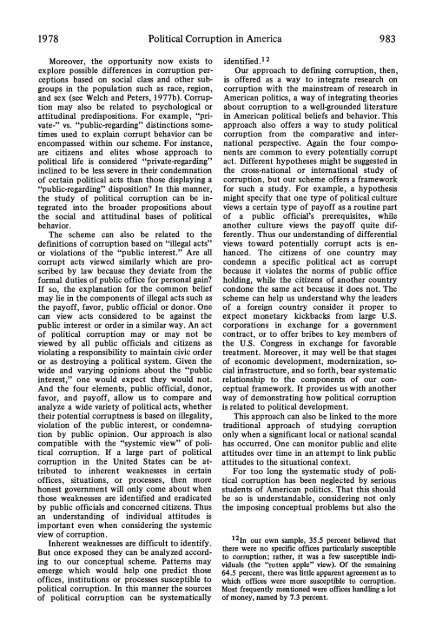Political Corruption in America: A Search for Definitions ... - See also
Political Corruption in America: A Search for Definitions ... - See also
Political Corruption in America: A Search for Definitions ... - See also
- No tags were found...
You also want an ePaper? Increase the reach of your titles
YUMPU automatically turns print PDFs into web optimized ePapers that Google loves.
1978 <strong>Political</strong> <strong>Corruption</strong> <strong>in</strong> <strong>America</strong> 983Moreover, the opportunity now exists toexplore possible differences <strong>in</strong> corruption perceptionsbased on social class and other subgroups<strong>in</strong> the population such as race, region,and sex (see Welch and Peters, 1977b). <strong>Corruption</strong>may <strong>also</strong> be related to psychological orattitud<strong>in</strong>al predispositions. For example, "private-"vs. "public-regard<strong>in</strong>g" dist<strong>in</strong>ctions sometimesused to expla<strong>in</strong> corrupt behavior can beencompassed with<strong>in</strong> our scheme. For <strong>in</strong>stance,are citizens and elites whose approach topolitical life is considered "private-regard<strong>in</strong>g"<strong>in</strong>cl<strong>in</strong>ed to be less severe <strong>in</strong> their condemnationof certa<strong>in</strong> political acts than those display<strong>in</strong>g a"public-regard<strong>in</strong>g" disposition? In this manner,the study of political corruption can be <strong>in</strong>tegrated<strong>in</strong>to the broader propositions aboutthe social and attitud<strong>in</strong>al bases of politicalbehavior.The scheme can <strong>also</strong> be related to thedef<strong>in</strong>itions of corruption based on "illegal acts"or violations of the "public <strong>in</strong>terest." Are allcorrupt acts viewed similarly which are proscribedby law because they deviate from the<strong>for</strong>mal duties of public office <strong>for</strong> personal ga<strong>in</strong>?If so, the explanation <strong>for</strong> the common beliefmay lie <strong>in</strong> the components of illegal acts such asthe payoff, favor, public official or donor. Onecan view acts considered to be aga<strong>in</strong>st thepublic <strong>in</strong>terest or order <strong>in</strong> a similar way. An actof political corruption may or may not beviewed by all public officials and citizens asviolat<strong>in</strong>g a responsibility to ma<strong>in</strong>ta<strong>in</strong> civic orderor as destroy<strong>in</strong>g a political system. Given thewide and vary<strong>in</strong>g op<strong>in</strong>ions about the "public<strong>in</strong>terest," one would expect they would not.And the four elements, public official, donor,favor, and payoff, allow us to compare andanalyze a wide variety of political acts, whethertheir potential corruptness is based on illegality,violation of the public <strong>in</strong>terest, or condemnationby public op<strong>in</strong>ion. Our approach is <strong>also</strong>compatible with the "systemic view" of politicalcorruption. If a large part of politicalcorruption <strong>in</strong> the United States can be attributedto <strong>in</strong>herent weaknesses <strong>in</strong> certa<strong>in</strong>offices, situations, or processes, then morehonest government will only come about whenthose weaknesses are identified and eradicatedby public officials and concerned citizens. Thusan understand<strong>in</strong>g of <strong>in</strong>dividual attitudes isimportant even when consider<strong>in</strong>g the systemicview of corruption.Inherent weaknesses are difficult to identify.But once exposed they can be analyzed accord<strong>in</strong>gto our conceptual scheme. Patterns mayemerge which would help one predict thoseoffices, <strong>in</strong>stitutions or processes susceptible topolitical corruption. In this manner the sourcesof political corruption can be systematicallyidentified.1 2Our approach to def<strong>in</strong><strong>in</strong>g corruption, then,is offered as a way to <strong>in</strong>tegrate research oncorruption with the ma<strong>in</strong>stream of research <strong>in</strong><strong>America</strong>n politics, a way of <strong>in</strong>tegrat<strong>in</strong>g theoriesabout corruption to a well-grounded literature<strong>in</strong> <strong>America</strong>n political beliefs and behavior. Thisapproach <strong>also</strong> offers a way to study politicalcorruption from the comparative and <strong>in</strong>ternationalperspective. Aga<strong>in</strong> the four componentsare common to every potentially corruptact. Different hypotheses might be suggested <strong>in</strong>the cross-national or <strong>in</strong>ternational study ofcorruption, but our scheme offers a framework<strong>for</strong> such a study. For example, a hypothesismight specify that one type of political cultureviews a certa<strong>in</strong> type of payoff as a rout<strong>in</strong>e partof a public official's prerequisites, whileanother culture views the payoff quite differently.Thus our understand<strong>in</strong>g of differentialviews toward potentially corrupt acts is en-hanced. The citizens of one country maycondemn a specific political act as corruptbecause it violates the norms of public officehold<strong>in</strong>g, while the citizens of another countrycondone the same act because it does not. Thescheme can help us understand why the leadersof a <strong>for</strong>eign country consider it proper toexpect monetary kickbacks from large U.S.corporations <strong>in</strong> exchange <strong>for</strong> a governmentcontract, or to offer bribes to key members ofthe U.S. Congress <strong>in</strong> exchange <strong>for</strong> favorabletreatment. Moreover, it may well be that stagesof economic development, modernization, social<strong>in</strong>frastructure, and so <strong>for</strong>th, bear systematicrelationship to the components of our conceptualframework. It provides us with anotherway of demonstrat<strong>in</strong>g how political corruptionis related to political development.This approach can <strong>also</strong> be l<strong>in</strong>ked to the moretraditional approach of study<strong>in</strong>g corruptiononly when a significant local or national scandalhas occurred. One can monitor public and eliteattitudes over time <strong>in</strong> an attempt to l<strong>in</strong>k publicattitudes to the situational context.For too long the systematic study of politicalcorruption has been neglected by seriousstudents of <strong>America</strong>n politics. That this shouldbe so is understandable, consider<strong>in</strong>g not onlythe impos<strong>in</strong>g conceptual problems but <strong>also</strong> the121n our own sample, 35.5 percent believed thatthere were no specific offices particularly susceptibleto corruption; rather, it was a few susceptible <strong>in</strong>dividuals(the "rotten apple" view). Of the rema<strong>in</strong><strong>in</strong>g64.5 percent, there was little apparent agreement as towhich offices were more susceptible to corruption.Most frequently mentioned were offices handl<strong>in</strong>g a lotof money, named by 7.3 percent.
















